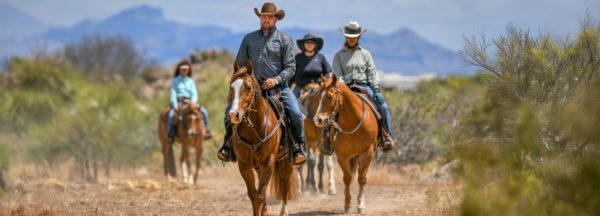August No Worries Club Preview: Training on the Trail


August No Worries Club Preview: Training on the Trail
Clinton Anderson from Downunder Horsemanship has developed a way to train horses, regardless of their past problems or traumas. It all begins with training the owners to gain their horse’s respect and understand how to properly control them. Join Clinton on his weekly endeavors of tackling some of the most challenging situations with problem horses and problem owners. This week, we get a preview of August’s No Worries Club.
This week, Clinton is back in Arizona to continue his work with a group of No Worries club members who are passionate about the Method and enjoy trail riding with their horses. In the first training session with the group, Clinton reviewed their Fundamentals and went over the bare minimum a horse and rider should know before leaving the arena. The review of groundwork and riding exercises polished the group’s skills and ensured that everyone was prepared for the next training session. Now, we’ll watch as Clinton takes the group of riders outside the arena and onto the trail. His goal is to show them how to train their horses on the trail to get them to walk, trot and canter and be productive all-around citizens.
Remember, great trail horses are confident and in tune with their riders. When the unexpected happens on the trail, they know they can trust their riders to guide them safely.
Clinton starts the lesson by explaining that they will mimic what they did in the arena, except on the trail. So, they’ll be training to make their horses pay attention because whenever you change environments, you tend to change horses—and usually not for the better. Clinton explains that the only way to get your horses to act well away from home is to take them away from home and teach them to be productive citizens.
To do this, Clinton explains to his group that the trail is their new arena. He lets everyone know that they’re going to review One Rein Stops, Bending at the Walk, Bending Transitions, and a ton of Post ‘N Circle around the bushes and cacti. After about three or four days of consistent training, the horses should be tuned in, relaxed and act just as well on the trail as they do in the arena.
The first thing that they work on is just Flexing at the Standstill. Most people don’t flex anywhere near enough, and they wonder why their horses aren’t soft. After that, Clinton advises everyone to work on the One Rein Stops at a walk and then at a trot. Practicing One Rein Stops helps prepare riders and their horses for emergency situations. Clinton lets his riders practice this for a while, giving them guidance and some constructive feedback as they move through the exercise. After practicing the exercise at a walk and trot, they move on to the canter.
Clinton reminds us that he can’t stress the importance of doing these One Rein Stops at all three gaits outside of the arena or on the trail, until they become second nature. The best way to achieve this? Repetition. This is going to help you stay safe and in control so you can handle any situation that comes your way. Clinton explains that One Rein Stops have saved his life at least six or seven times because when he realized he was in danger, he could automatically stop his horse and regain control of the situation. The only way you get that good is to just practice doing One Rein Stops until you can do them in your sleep.
Clinton Anderson has devoted over 20 years to creating the best training tools and videos available to horsemen worldwide. To learn more about the Downunder Horsemanship training method or become a member of the No Worries Club, download the Downunder Horsemanship app today!

